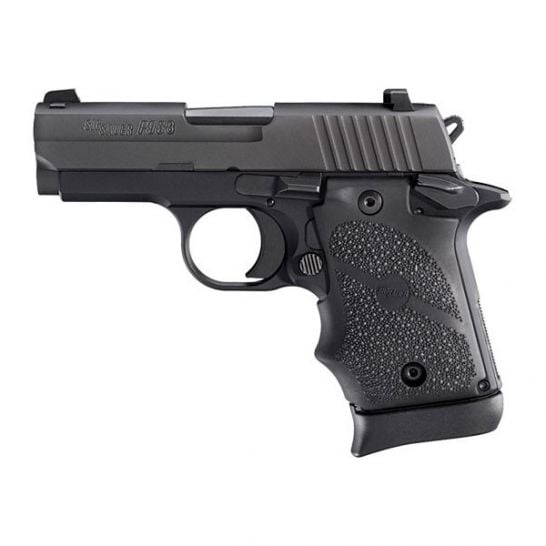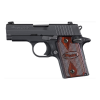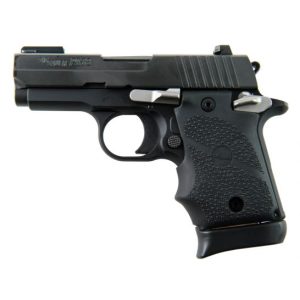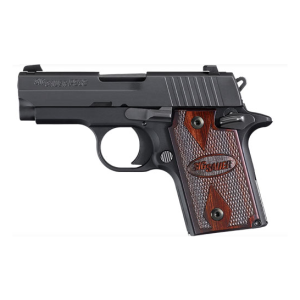Sig Sauer P938 9mm Pistol, Nitron SAO BLK u2013 938-9-BRG-AMBI For Sale
$699.99
The Sig Sauer P938 9mm Pistol, model 938-9-BRG-AMBI, is a compact yet powerful firearm designed for shooters who prioritize both performance and portability. Similar in size to the popular P238, the P938 packs substantial power into its small frame. It features an exceptional single-action trigger that enhances accuracy, complemented by full-size SIGLITE Night Sights for effective target acquisition in low-light conditions, giving it the feel of a larger pistol. Its Nitron finish and ergonomic design offer both durability and comfort, making it aesthetically appealing and practical. Ideal for concealed carry, the P938 strikes an optimal balance between size, power, and handling.
What are the cons of the SIG P938?
The SIG P938 is a popular subcompact pistol, but like any firearm, it has its drawbacks. Here are some potential cons:
1. **Price**: The SIG P938 can be more expensive than other comparable subcompact pistols, making it a significant investment for some buyers.
2. **Recoil**: Given its small size and light weight, some users may find the recoil more noticeable and harder to manage, especially for those with less shooting experience.
3. **Trigger Pull**: Some shooters find the trigger pull to be a bit heavier than they prefer, which can impact accuracy and comfort during extended shooting sessions.
4. **Capacity**: The standard magazine capacity is lower than many other compact and subcompact pistols, typically holding 6 to 7 rounds, which could be a limitation for those seeking higher capacity options.
5. **Grip Size**: The compact size might make the grip feel small or uncomfortable for individuals with larger hands, leading to less control and comfort.
6. **Manual Safety**: While many appreciate a manual safety for added security, others may find it to be an unnecessary feature that complicates the draw and fire process under stress.
7. **Limited Accessory Rail**: The small frame size restricts the ability to attach lights or lasers, limiting customization options.
These cons can vary based on personal preference and intended use, so it’s important to consider how these factors align with individual needs and practices.
How many bullets does a SIG P938 hold?
The SIG P938 typically holds 6 to 7 rounds in its magazine, depending on the specific model and magazine used.
What SIG Sauer did Navy SEALs use?
The Navy SEALs have used the SIG Sauer P226 as one of their standard sidearms.
Is the SIG P938 a pocket pistol?
Yes, the SIG P938 is considered a pocket pistol due to its small size and compact design, making it suitable for concealed carry.
Is Sig better then Glock?
The debate on whether Sig Sauer or Glock is better is largely subjective and depends on personal preferences and intended use. Here are some factors to consider:
1. **Ergonomics and Comfort**: Sig Sauer pistols are often praised for their ergonomic design and comfortable grip, which can be a significant factor for many users. Glock pistols are known for their simplicity and functional design, which some find less comfortable but highly reliable.
2. **Reliability**: Both Sig Sauer and Glock have reputations for reliability. Glock is particularly noted for its ease of maintenance and fewer parts, which can contribute to its reliability under harsh conditions.
3. **Trigger**: Sig Sauer pistols typically have a double-action/single-action (DA/SA) trigger system, which some shooters prefer for its versatility. Glocks have a consistent trigger pull, which some find easier to manage in rapid-fire situations.
4. **Price**: Glocks are generally more affordable than Sig Sauer pistols, making them a popular choice for those on a budget or for agencies outfitting large numbers of personnel.
5. **Customization and Aftermarket Support**: Glock pistols have a massive aftermarket community, providing extensive options for customization. While Sig Sauer also has good support, it is not as extensive as Glock’s.
Ultimately, the choice between Sig Sauer and Glock comes down to personal preference. It’s advisable to handle and, if possible, shoot both to see which one fits your needs and preferences better.
Which Sig Sauer has issues?
Some Sig Sauer models have been reported to have issues. Notably, the Sig Sauer P320 has been subject to controversy and scrutiny due to claims of accidental discharges when dropped or impacted. It’s important for gun owners to stay informed and check for any recalls or safety notices from the manufacturer or relevant authorities.
Does the Sig Sauer P938 have a safety?
Yes, the Sig Sauer P938 does have a manual safety.
What SIG Sauer did John Wick use?
John Wick used a SIG Sauer P320 in the movie “John Wick: Chapter 2.”
What is the difference between single action and double action?
The difference between single action and double action primarily refers to the mechanism of firearms, specifically how the trigger and hammer operate together. Here’s a breakdown:
1. **Single Action (SA):**
– **Trigger Function:** In a single action firearm, pulling the trigger performs only one action: releasing the hammer or striker to fire the gun.
– **Hammer/Striker Operation:** The hammer or striker must be manually cocked before the trigger is pulled. This is typically done by pulling back the hammer or by racking the slide, depending on the type of firearm.
– **Trigger Pull:** Single action triggers generally have a lighter and shorter pull because pulling the trigger releases the already-cocked hammer or striker.
– **Examples:** Traditional revolvers when the hammer is cocked manually, and many semi-automatic pistols like the M1911 when the slide is racked.
2. **Double Action (DA):**
– **Trigger Function:** In a double action firearm, pulling the trigger performs two actions: it both cocks and releases the hammer or striker.
– **Hammer/Striker Operation:** The trigger pull both pulls back and releases the hammer, or it cocks and releases a striker, depending on the design.
– **Trigger Pull:** Double action triggers tend to have a longer and heavier pull since the trigger must do more work (cocking and releasing).
– **Examples:** Many revolvers (in double action mode) and pistols like the SIG Sauer P226 which can be fired in double action mode for the first shot.
Some firearms offer both single action and double action modes, known as double-action/single-action (DA/SA), where the first shot is double action and subsequent shots are single action as the slide automatically cocks the hammer after firing.
What pistol does the FBI use?
The FBI primarily uses the Glock 19M and Glock 17M as their standard-issue pistols. These models are part of the Glock “M” series, which was designed to meet the specific requirements and standards of the FBI.
Why did SEALs switch from Sig to Glock?
The U.S. Navy SEALs switched from the Sig Sauer P226 to the Glock 19 for several reasons:
1. **Reliability and Durability**: Glock pistols are known for their reliability under various conditions. They perform well in extreme environments, which is crucial for special operations.
2. **Weight and Size**: The Glock 19 is lighter and more compact than the Sig P226, making it more convenient for SEALs to carry during missions.
3. **Modularity and Customization**: The Glock platform allows for greater customization and modularity, enabling operators to modify the pistol with attachments and accessories according to their needs.
4. **Ease of Maintenance**: Glocks are easier to maintain and disassemble, which is beneficial for field operations where clean and operational weapons are critical.
5. **Standardization**: Glock pistols are widely used across various branches of the U.S. military and law enforcement, promoting standardization and simplifying logistics.
These factors collectively led to the adoption of the Glock 19 by the Navy SEALs.
What pistol do marines carry?
The U.S. Marines typically carry the M18 pistol, which is a compact variant of the SIG Sauer P320.
How many bullets does a sig 9mm hold?
The magazine capacity of a Sig Sauer 9mm handgun can vary depending on the specific model. For example, the Sig Sauer P320 typically has a standard magazine capacity of 15 to 17 rounds for its 9mm version, while the P365 often holds 10 to 12 rounds. It’s important to check the specifications for the specific model you are interested in.
How many rounds does a star 9mm hold?
A standard Star 9mm pistol magazine typically holds between 8 to 15 rounds, depending on the specific model and magazine size. It’s best to refer to the specific model you have in mind for an exact capacity.
How many rounds does a Sig P238 have?
The Sig P238 typically has a magazine capacity of 6 rounds. However, there are extended magazines available that can hold more rounds.
| Action | Semi-Auto |
|---|---|
| Frame Size | Micro-Compact |
| Trigger Pull | 7.5 lbs |
| Overall Length | 5.9" |
| Overall Width | 1.1" |
| Safety | Ambidextrous |
Be the first to review “Sig Sauer P938 9mm Pistol, Nitron SAO BLK u2013 938-9-BRG-AMBI” Cancel reply
Related products
Sig Sauer P938 9mm
Sig Sauer P938 9mm




Reviews
There are no reviews yet.